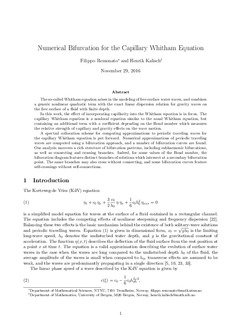| dc.contributor.author | Remonato, Filippo | |
| dc.contributor.author | Kalisch, Henrik | |
| dc.date.accessioned | 2017-11-29T08:53:48Z | |
| dc.date.available | 2017-11-29T08:53:48Z | |
| dc.date.created | 2017-02-07T10:59:02Z | |
| dc.date.issued | 2017 | |
| dc.identifier.citation | Physica D : Non-linear Phenomena. 2017, 343 51-62. | nb_NO |
| dc.identifier.issn | 0167-2789 | |
| dc.identifier.uri | http://hdl.handle.net/11250/2468338 | |
| dc.description.abstract | The so-called Whitham equation arises in the modeling of free surface water waves, and combines a generic nonlinear quadratic term with the exact linear dispersion relation for gravity waves on the free surface of a fluid with finite depth. In this work, the effect of incorporating capillarity into the Whitham equation is in focus. The capillary Whitham equation is a nonlocal equation similar to the usual Whitham equation, but containing an additional term with a coefficient depending on the Bond number which measures the relative strength of capillary and gravity effects on the wave motion. A spectral collocation scheme for computing approximations to periodic traveling waves for the capillary Whitham equation is put forward. Numerical approximations of periodic traveling waves are computed using a bifurcation approach, and a number of bifurcation curves are found. Our analysis uncovers a rich structure of bifurcation patterns, including subharmonic bifurcations, as well as connecting and crossing branches. Indeed, for some values of the Bond number, the bifurcation diagram features distinct branches of solutions which intersect at a secondary bifurcation point. The same branches may also cross without connecting, and some bifurcation curves feature self-crossings without self-connections. | nb_NO |
| dc.language.iso | eng | nb_NO |
| dc.publisher | Elsevier | nb_NO |
| dc.relation.uri | http://www.sciencedirect.com/science/article/pii/S0167278916302135 | |
| dc.title | Numerical bifurcation for the capillary Whitham equation | nb_NO |
| dc.type | Journal article | nb_NO |
| dc.description.version | submittedVersion | nb_NO |
| dc.subject.nsi | VDP::Matematikk: 410 | nb_NO |
| dc.subject.nsi | VDP::Mathematics: 410 | nb_NO |
| dc.source.pagenumber | 51-62 | nb_NO |
| dc.source.volume | 343 | nb_NO |
| dc.source.journal | Physica D : Non-linear Phenomena | nb_NO |
| dc.identifier.doi | 10.1016/j.physd.2016.11.003 | |
| dc.identifier.cristin | 1447737 | |
| dc.relation.project | Norges forskningsråd: 231668 | nb_NO |
| dc.relation.project | Norges forskningsråd: 213474/F20 | nb_NO |
| dc.description.localcode | This is a submitted manuscript of an article published by Elsevier Ltd in Physica D: Nonlinear Phenomena, 6 December 2016. | nb_NO |
| cristin.unitcode | 194,63,15,0 | |
| cristin.unitname | Institutt for matematiske fag | |
| cristin.ispublished | true | |
| cristin.fulltext | preprint | |
| cristin.qualitycode | 2 | |
